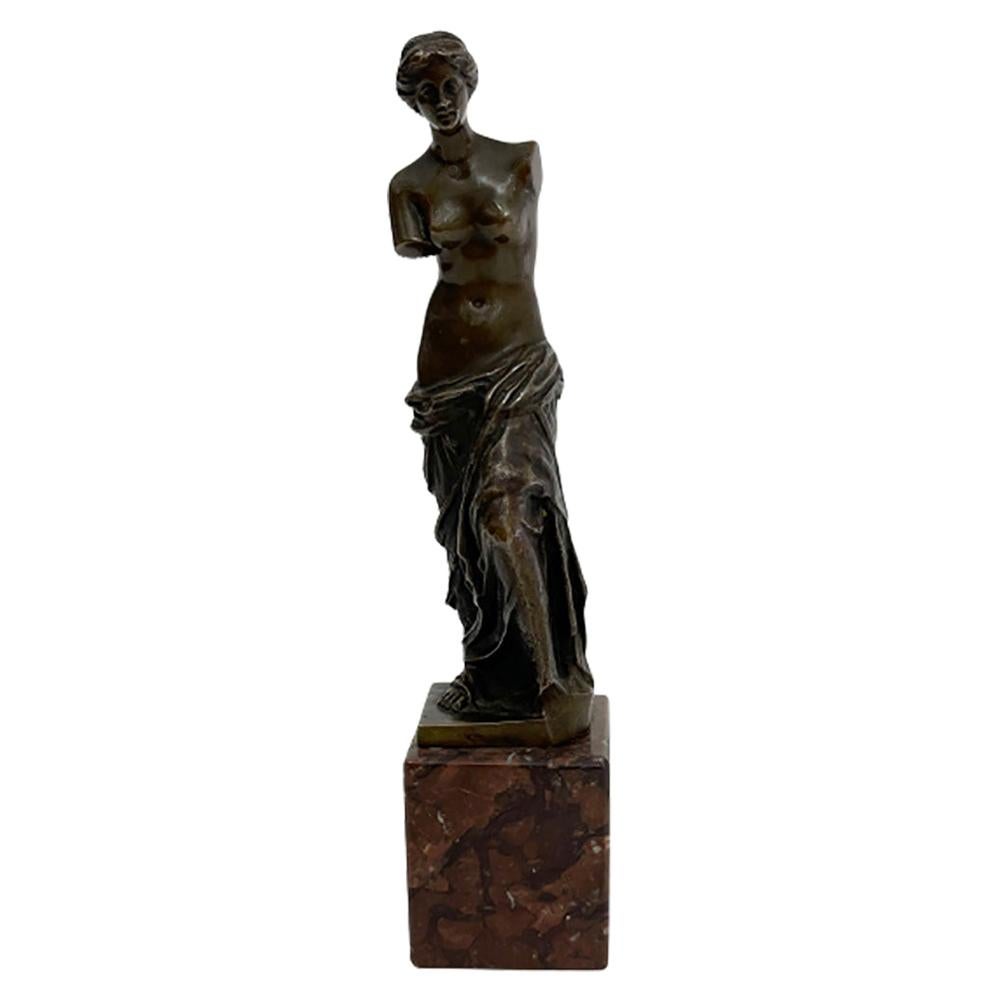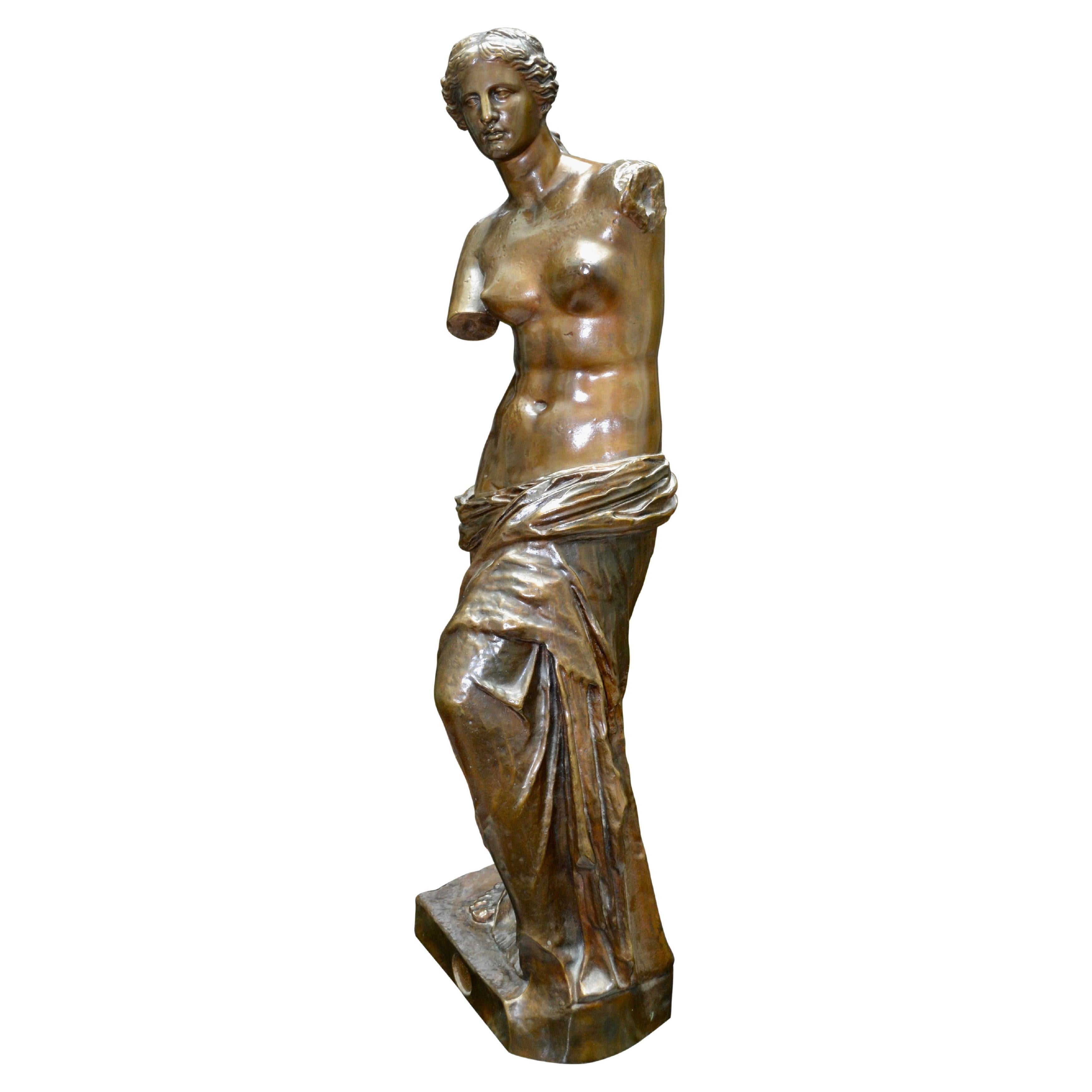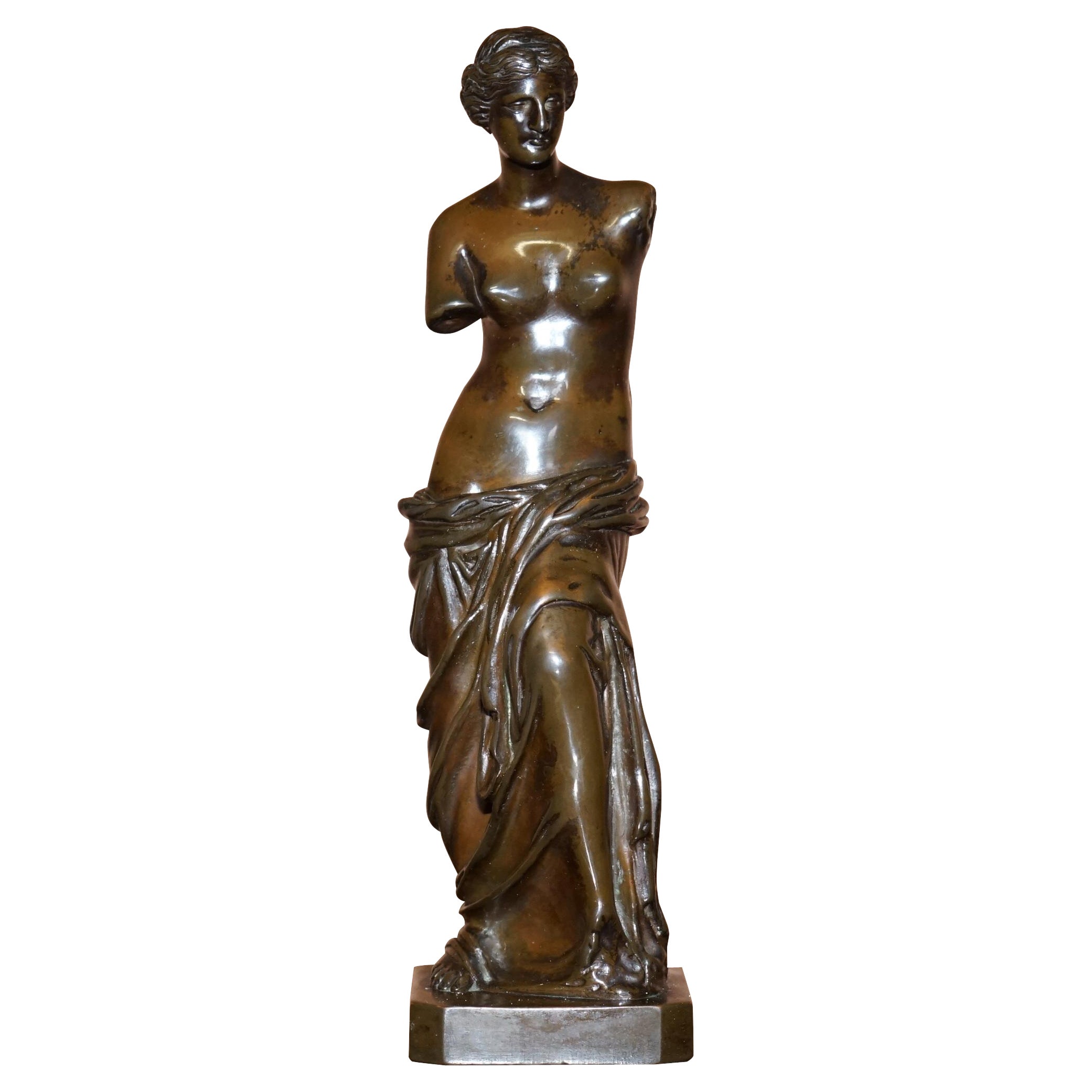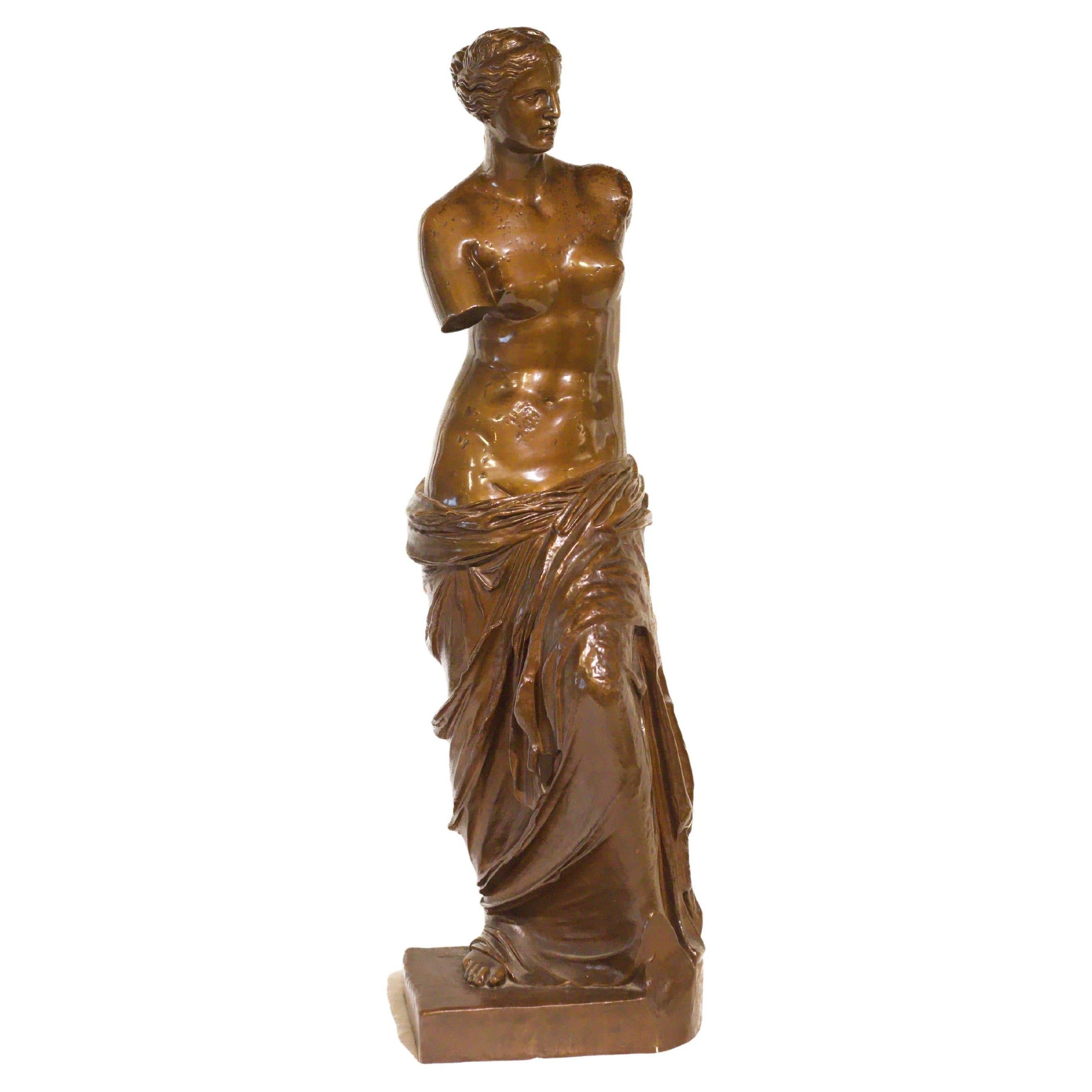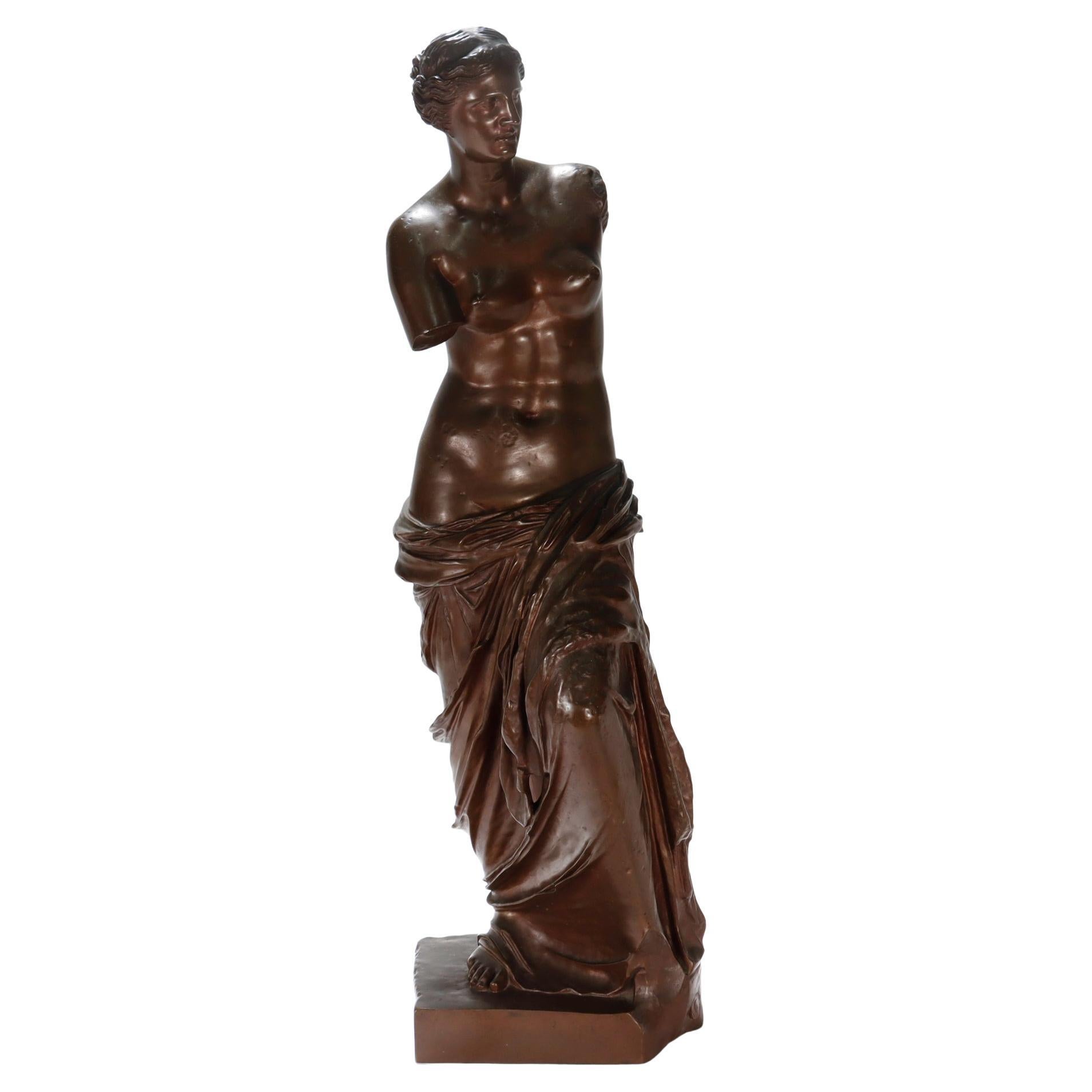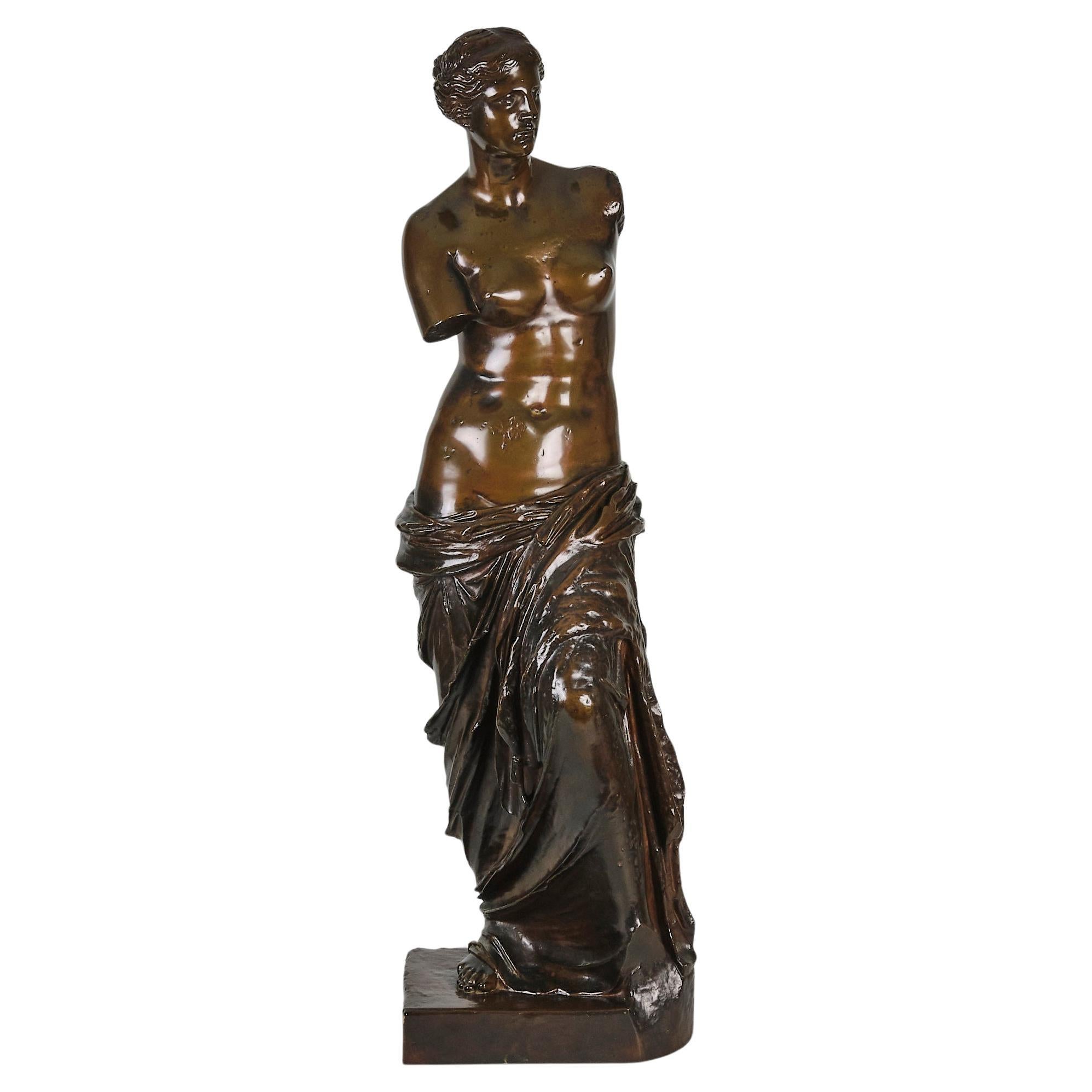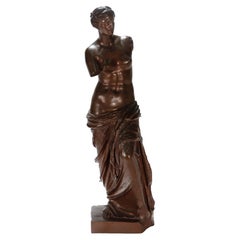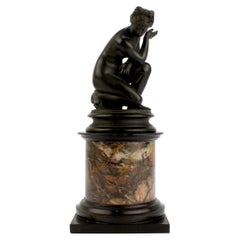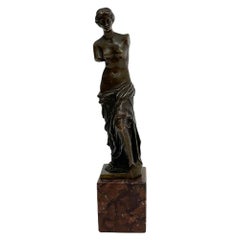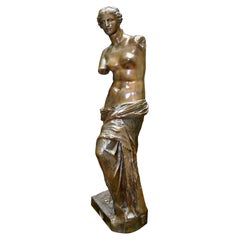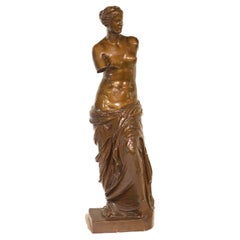Items Similar to Cabinet Size Bronze Sculpture of Venus de Milo after Ron Liod Sauvage
Want more images or videos?
Request additional images or videos from the seller
1 of 13
Cabinet Size Bronze Sculpture of Venus de Milo after Ron Liod Sauvage
$1,250
£944.55
€1,093.24
CA$1,753.69
A$1,950.60
CHF 1,023.28
MX$23,801.81
NOK 12,843.51
SEK 12,103.45
DKK 8,160.55
About the Item
A fine Venus de Milo bronze after Sauvage.
In an diminutive size that is perfect for the desk, mantel or vitrine.
Simply a wonderful little bronze in the Grand Tour or Kunstkammer traditions of objet.
Measures: Height: ca. 6 3/8 in.
- Creator:Ron Sauvage (Artist)
- Dimensions:Height: 6.38 in (16.21 cm)Width: 1.75 in (4.45 cm)Depth: 1.5 in (3.81 cm)
- Style:Grand Tour (In the Style Of)
- Materials and Techniques:
- Place of Origin:
- Period:
- Date of Manufacture:20th Century
- Condition:Wear consistent with age and use. With some light edge wear, some spots of wear to the patina, some very fine and light surface scratches throughout and other signs of light wear consistent with age.
- Seller Location:Philadelphia, PA
- Reference Number:1stDibs: LU1610212961791
About the Seller
5.0
Platinum Seller
Premium sellers with a 4.7+ rating and 24-hour response times
Established in 1996
1stDibs seller since 2015
549 sales on 1stDibs
Typical response time: <1 hour
- ShippingRetrieving quote...Shipping from: Philadelphia, PA
- Return Policy
Authenticity Guarantee
In the unlikely event there’s an issue with an item’s authenticity, contact us within 1 year for a full refund. DetailsMoney-Back Guarantee
If your item is not as described, is damaged in transit, or does not arrive, contact us within 7 days for a full refund. Details24-Hour Cancellation
You have a 24-hour grace period in which to reconsider your purchase, with no questions asked.Vetted Professional Sellers
Our world-class sellers must adhere to strict standards for service and quality, maintaining the integrity of our listings.Price-Match Guarantee
If you find that a seller listed the same item for a lower price elsewhere, we’ll match it.Trusted Global Delivery
Our best-in-class carrier network provides specialized shipping options worldwide, including custom delivery.More From This Seller
View AllLarge Signed Barbedienne Antique French Bronze Sculpture of the Venus de Milo
By F. Barbedienne Foundry
Located in Philadelphia, PA
A fine antique bronze sculputre.
Depicting the Venus de Milo.
After the ancient model by Alexandros of Antioch.
Bearing an Achille Collas reduction seal and a Barbedienne mark.
P...
Category
Antique 19th Century French Belle Époque Figurative Sculptures
Materials
Bronze
Antique Grand Tour Bronze Sculpture of the Crouching Venus after Giambologna
By Giambologna
Located in Philadelphia, PA
A very fine Grand Tour bronze sculpture.
Modeled after the 'Crouching Venus' by Giambologna.
Depicting Venus surprised at her bath with an overturned urn at her feet. Mounted o...
Category
Antique 19th Century Italian Grand Tour Figurative Sculptures
Materials
Bronze
Diane De Gabies Silvered Grand Tour Bronze Sculpture by Gautier & Albinet
By Gautier A Paris
Located in Philadelphia, PA
A finely scaled model of the Diane de Gabies published by Gautier and Albinet.
With a wonderful distressed silvered surface throughout.
The Diane de Gabies is modeled after th...
Category
Antique Late 19th Century French Grand Tour Figurative Sculptures
Materials
Bronze
Mid 20th Century Valsuani Bronze Sculpture of a Martiniquaise after Paul Gauguin
By Valsuani Foundry, Paul Gauguin
Located in Philadelphia, PA
A very fine bronze of the 'Martiniquaise' or 'Woman of Martinique' sculpture after Paul Gauguin.
This bronze was modeled after the 'Woman of Martinique' or 'Femme de la Martinique' ...
Category
20th Century French Modern Figurative Sculptures
Materials
Bronze
Small Hans Müller Art Nouveau Bronze Cabinet Sculpture/Bust of a Half-Clad Woman
By Hans Muller
Located in Philadelphia, PA
A fine, small-scale antique Art Nouveau cabinet bronze.
In the form of a half-naked young woman in three-quarter profile.
Likely an allegory to Summer or The Harvest (or possibly a...
Category
Early 20th Century Unknown Art Nouveau Busts
Materials
Bronze
Antique French Bronze Sculpture of a Woman with Marble Plinth by Louis Lerolle
By Lerolle Freres, Lerolle
Located in Philadelphia, PA
A fine antique French bronze sculpture.
By Louis Lerolle (ca. 1868-1948)
In gilt bronze with a darkened finish.
In the form of a well-dressed woman with a large hat putting on a g...
Category
Early 20th Century French Belle Époque Figurative Sculptures
Materials
Marble, Bronze
You May Also Like
Small Bronze Statue of Venus De Milo
Located in Delft, NL
A small bronze statue of Venus de Milo
A small French bronze statue of Venus de Milo or Aphrodite on a marble base.
The original Venus de Milo statue...
Category
Antique Late 19th Century French Figurative Sculptures
Materials
Marble, Bronze
19th Century Grand Tour Bronze Statue of Venus of Milo
Located in Vancouver, British Columbia
A very fine Grand Tour bronze study of the famous Venus de Milo with excellent rich brown patina and good hand finished surface detail. The casting is unusual in that it does not pretend to hide the many imperfections on the original.
It is signed on the base with "Reduction Mechanique Ronald Collas, and for the foundry F.Barbidienne Fondeur. Foundry stamp on the base
Considered by any to be the most beautiful Hellenistic statue to survive fro antiquity, the Venus of Milos...
Category
Antique Late 19th Century French Neoclassical Figurative Sculptures
Materials
Bronze
Lovely 19th Century Antique Italian Venus De Milo Grand Tour Bronze Statue
Located in West Sussex, Pulborough
We are delighted to offer for sale this stunning late 19th century Italian grand tour Venus De Milo statue
A very good looking and decorative piec...
Category
Antique 19th Century Italian Victorian Figurative Sculptures
Materials
Bronze
$1,301 Sale Price
30% Off
Late 19th Century French Ferdinand Barbedienne Bronze Venus de Milo Sculpture
By Ferdinand Barbedienne
Located in Miami, US
This exquisite bronze sculpture of the Venus de Milo dates to the late 19th century and is a beautifully detailed representation of the iconic ancient Greek statue. With a rich brown...
Category
Antique Late 19th Century French Classical Greek Figurative Sculptures
Materials
Bronze
Late 19th Century Art Nouveau Sculpture "Venus de Milo" by F. Barbedienne
By F. Barbedienne Foundry
Located in London, GB
A large and impressive late 19th Century bronze study of the famous Venus de Milo sculpture of antiquity with excellent rich brown patina and good hand finished surface detail, inscribed F.Barbedienne foundry
ADDITIONAL INFORMATION
Height: 95 cm
Width: 28 cm
Depth: 28 cm
Condition: Excellent Original Condition
Circa: 1890
Materials: Bronze
Foundry: F.Barbedienne
SKU: 7741
ABOUT
The Barbedienne Foundry is a famous 19th century bronze foundry, whose statues and art objects became rapidly very renowned. This bronze studio co-worked with other trades, and put his name to a great variety of works, such as furnishing in particular. Attending every World's Fair of its time, the Barbedienne Foundry was regularly awarded, notably at the World's Fair of 1855 where it was awarded the Great Medal of Honor.
A Parisian bronze maker and caster, Ferdinand Barbedienne (1810-1892) creates a firm in 1839 in collaboration with Achille Collas, the inventor of the mechanical method to obtain copies of sculptures at a smaller scale. With this groundbreaking proceed, they facilitated an unprecedented production. Under the “Collas et Barbedienne” name, they specialized in Antiquity copies and perfected new chemical methods for the color and patina finish of their bronzes. As a true Romantic, Ferdinand Barbedienne is committed to democratization of arts, he thus realizes numerous Antiquity copies and stimulates his contemporaries’ works broadcasting. A great deal of famous sculptures are hence cast by the Barbedienne Foundry. All his life, Barbedienne co-worked with the greatest artists, sculptors or designers of his time, such as Edouard Lievre, Ferdinand Levillain, Attarge, Aizelin, Barye or Fremiet.
Statues aside, he products a great deal of decorative artifacts, such as clocks, vases, mirrors, etc. Since 1855, Ferdinand Barbedienne collaborates with the famous decoration designer Louis-Constant Sévin (1821-1888). Joining the firm as a sculptor-designer, he stays loyal to it his life long, always finding more new designs for daily objects, which hence become true art works. Sevin’s creations, specialized in the “Neo-Greek” style, were particularly appreciated for antiquity reference in decorative arts, just like the great mirror preserved by the Orsay Museum. He also teams up with enamelers including Alfred Serre, and develops a set of “cloisonnés” enamels that made the headlines at the World's Fair of 1862 in London, which was the very beginning of the art of enamel’s return. In collaboration with Serre, Barbedienne realized between 1878 and 1889 the Monumental Clock in Renaissance style, decorated with enamels, which is preserved in the Paris City Hall.
Venus de Milo
Facts about Venus de Milo sculpture.
For much of the world, the mystery of the Venus de Milo lies in her missing arms. But there’s much more to this iconic statue than a couple of absent appendages.
1. Venus de Milo‘s title is a bit misleading.
It’s popularly believed that this Grecian statue depicts the Greek Goddess of love and beauty, who was often rendered half-naked. However, the Greeks would have called this deity Aphrodite. Nonetheless, the Roman-inspired Venus de Milo caught on.
2. She’s named in part for where she was discovered.
On April 8, 1820, a farmer named Yorgos Kentrotas came across the statue in pieces within the ruins of an ancient city on the island of Milos (formerly known as Melos).
3. Alexandros of Antioch is credited with her creation.
A sculptor of the Hellenistic period, Alexandros is believed to have carved this masterpiece between 130 and 100 BCE. The inscription on the plinth—the slab on which the statue rested—that identified him as Venus de Milo‘s creator was lost nearly 200 years ago.
4. She might not be Venus.
Some have suggested the sculpture is not Aphrodite/Venus, but Amphitrite, the sea goddess who was particularly adored on Milos. Still others have proposed she’s Victory, or perhaps a prostitute. With her arms long missing, would-be context clues have been lost for centuries. A spear could have meant one thing, a spool of thread another. If she held an apple—as some reports claim—it could mean she was Aphrodite, holding the award given to her by Paris before the Trojan War began. To this day, it’s a matter of passionate debate.
5. She became a gift to the King of France.
When Kentrotas called upon a French naval officer to help him unearth the spectacular sculpture, he began a chain of events that would eventually lead to the Marquis de Rivière presenting Venus de Milo to Louis XVIII. In turn, the ruler gave the statue to the Louvre, where it is on display to this very day.
6. The loss of her limbs is the fault of the French.
Kentrotas did find fragments of an arm and a hand when he uncovered the statue in the ruins, but as Venus de Milo was being reassembled, those arms were discarded for having a “rougher” appearance. Modern art historians believe that the variation of finish does not mean those arms did not belong to Venus, but both the arms and the original plinth have been lost since the piece moved to Paris in 1820.
7. The original plinth was ditched on purpose.
Sight unseen, early 19th century art historians decided the newly discovered Venus must have been the work of Greek artist Praxiteles, and publicized the work as such. This attribution would have placed the piece in the Classical period (5th through 4th centuries BCE), which was more respected artistically than the Hellenistic period. To save face and better promote Venus de Milo—even at the cost of misinforming the public—the plinth was removed before it was presented to the King.
8. Venus de Milo was meant to make up for a national embarrassment.
During his conquests, Napoleon Bonaparte had plundered one of the finest examples of Greek sculpture, Venus de’ Medici, from Italy. In 1815, the French government returned that beloved sculpture, but in 1820, France embraced the chance to fill the hole its absence left in the French culture and national pride. As such, Venus de Milo was promoted as being even greater than Venus de’ Medici upon her Louvre debut. The ploy worked, and the piece was met with almost universal praise from artists and critics.
9. Renoir was not impressed.
Perhaps the most famous of Venus de Milo‘s detractors, the celebrated Impressionist painter dismissed this delicate depiction of grace and female beauty as “a big gendarme.”
10. She went into hiding during World War II.
By the autumn of 1939, war threatened to descend on Paris, so Venus de Milo along with some other priceless pieces, such as Winged Victory of Samothrace and Michelangelo’s Slaves, were whisked away for safekeeping at various châteaux in the French countryside.
11. She’s been robbed!
Venus is missing more than just her arms. She was originally draped in jewellery including a bracelet, earrings and a headband. These flourishes are long lost, but the holes for fixing them to the piece remain in the marble, giving clues to the missing accessories.
12. She lost her colour.
While it’s easy for today’s art admirers to think of Greek statues as white, the marble was often painted in the style of polychromy. However, no trace of the original paint scheme remains on Venus de Milo today.
13. She’s taller than most people.
Even with her slight slouch, Venus de Milo stands at 6 feet 8 inches tall.
14. She could be a copy.
Art historians have noted that Venus de Milo bears a striking resemblance to Aphrodite of Capua, which is a Roman era copy of a possibly late 4th century BCE bronze Greek original. That would be at least 170 years before Alexandros carved his goddess, leading some to speculate that both statues are actually replicas of an older statue...
Category
Antique Late 19th Century French Art Nouveau Figurative Sculptures
Materials
Bronze
Bronze Statuette of Venus, 2nd Half 19th Century
Located in Greding, DE
Small dark patinated figure of Venus on round profiled plinth.
Category
Antique Mid-19th Century European Grand Tour Figurative Sculptures
Materials
Bronze
More Ways To Browse
Venus Bronze
Milo Bronze
Venus De Milo
Diminutive Desk
Grand Tour Venus
Milo Bronze Sculpture
Venus De Milo Bronze
19th Century French Marble Sculpture
Rome Model
Austrian Figure
French Bronze Figurative Sculpture 19th Century
Roman Head
Dancer Sculptures
Gold Artifacts
Belgian Bronze Sculptures
Wood Carved Figural Sculpture
Antique Goddess
Ancient Greek Sculpture
